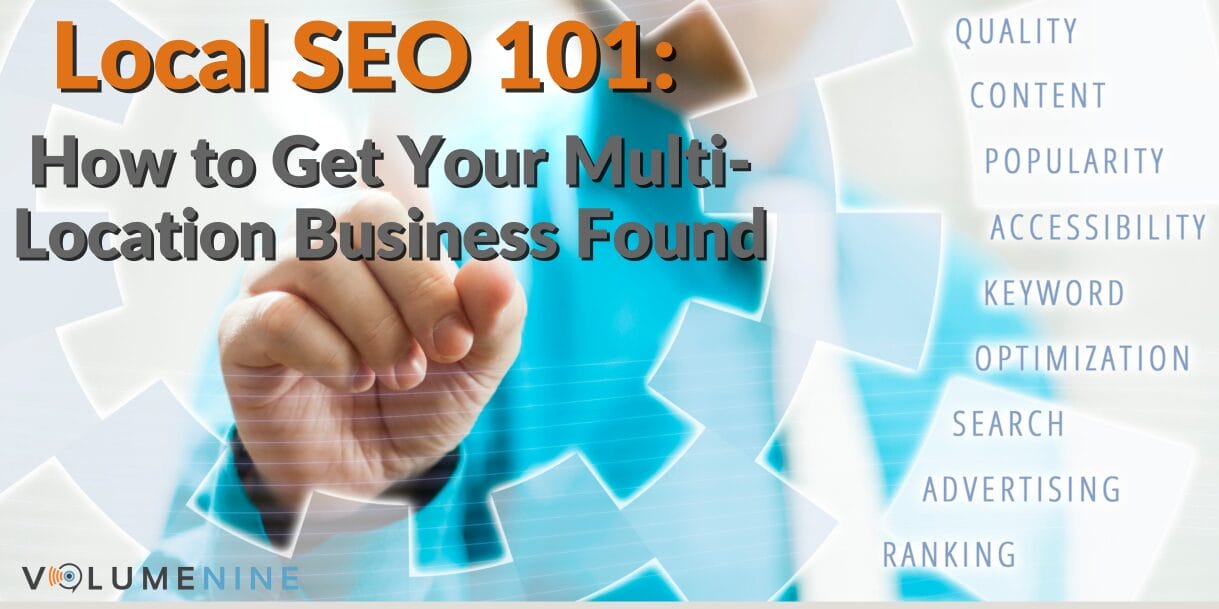
Local SEO 101: How to Get Your Multi-Location Business Found
Struggling to get your multi-location business noticed in local searches?
You’re not alone. Reaching the right audience in the right places is a problem that many businesses face. We at Volume Nine know how painful local SEO can be because we’ve been guiding clients through its intricacies for more than ten years.
So, whether your goal is to draw more foot traffic or strengthen your connection with local audiences, we have you covered.
What Is Multi-Location SEO?
Multi-location SEO means optimizing each branch or location of your business so it shows up in local searches. If you’ve got a coffee shop in Miami and another in Denver, local SEO ensures both pop up when someone nearby Googles, “best coffee near me.”
But how does this differ from traditional SEO?
Traditional SEO aims for broader, often global visibility. In contrast, multi-location SEO concentrates on very localized queries, such as “boutique gyms in Chicago.” Targeting clients in a certain location with precision is more important than trying to reach as many people as possible.
And why should you bother? It’s simple. It improves conversions, draws more foot traffic, and fosters local trust.
Why Local SEO Matters
So, let’s take a look at why local SEO deserves your attention:
Foot Traffic
Think about the last time you searched for “pizza near me” or “best auto repair shop in town.” Your customers are doing the same thing, and you are losing out on their business if your company is not listed in those local search results.
Simplify the Customer’s Journey
Nobody likes searching for an invalid phone number or sorting through out-of-date company hours. You make your clients’ lives easier by providing them with precise and consistent information at every location. They are more inclined to pick you over the competition if it is simpler for them.
Boost Conversions
Local SEO offers incredible value because it targets customers who are ready to act. Whether they’re calling for a quote or walking into your store, these aren’t passive browsers—they’re potential buyers.
Outpace the Competition
In many areas, businesses still struggle with implementing effective local SEO strategies. This creates an opening for you to shine. You can outperform competitors in search results and in the eyes of prospective buyers when your listings stay updated and your content speaks to local audiences.
Key Strategies for Optimizing Local SEO for Multiple Locations
Local SEO can feel like balancing on a unicycle while juggling. But don’t worry. It’s much easier to handle with the correct tactics.
Optimize Google Business Profile (GBP) Listings
GBP is a critical tool for making sure your locations appear in local search results. How do you optimize your GBP? Let’s break it down:
- Claim Each Location’s Listing: Start by creating or claiming a GBP Profile for every branch. This step plants your flag on the map, letting potential customers know you’re ready to serve them.
- Be Consistent with NAP Information: Your Name, Address, and Phone number (NAP) details should match across every online platform. Why? Inconsistencies confuse search engines and customers, costing you both visibility and trust.
- Keywords: Use keywords that resonate with the specific area. Whether it’s “best tacos in Brooklyn” or “auto repair in Austin,” weave local terms into your GBP descriptions without overdoing it.
- Keep It Fresh: Think of your GBP like a storefront window—it should always look its best. Regularly update listings with sharp photos, customer reviews, and timely updates on events, promotions, or hours.
Create Location-Specific Landing Pages
Every location deserves its own dedicated page. This allows you to customize content and attract local searches effectively. Include the following:
Keywords tied to the area’s interests.
- A clickable, embedded Google Map for easy navigation.
- Up-to-date NAP information prominently displayed.
- Testimonials from happy local customers.
- Promotions and offers that speak to the neighborhood.
Next, it’s important to use schema markup to stand out. Schema markup might sound technical but think of it as adding a “hello” sign to your content for search engines. It helps Google better understand your page and display key details directly in search results.
Develop Localized Content
Here are some things to keep in mind when crafting content that resonates locally:
- Be Specific: Create blog posts and guides that capture local interests. Think “5 Best Coffee Spots in Chicago” or “A Weekend Guide to Denver’s Outdoor Adventures.” Generic content will not help you rank locally, you need to be specific.
- Spotlight Local Events and News: Is your location hosting a charity event? Did your team sponsor a community sports league? Share these stories. Highlighting your local involvement strengthens your connection with the community and earns their trust.
- Leverage Customer Contributions: Your customers are your best advocates. Include their reviews, photos, and testimonials on your location pages.
Build Local Backlinks and Citations
Backlinks and citations are also necessary to build your business’s local reputation in the eyes of search engines. They show search engines—and your customers—that your locations are valued within the community.
- Collaborate With Local Allies: Join forces with nearby businesses, nonprofits, or event organizers. These collaborations, which can include co-hosting a workshop or sponsoring a festival, frequently result in beneficial backlinks from respective websites.
- Get Listed in Local Directories: Make a claim on websites such as Yelp, TripAdvisor, and directories tailored to your industry. These mentions help search engines connect your business to its physical location.
- Maintain Consistency in Citations: Your business name, address, and phone number should match across all directories. Inconsistent details can confuse search engines and knock your credibility.
Leverage Social Media for Local Engagement
Social media offers an incredible opportunity to connect with local audiences. Here are some strategies:
- Separate Pages: If managing distinct pages for each location is practical, it can create a sense of community for each area. Customers love seeing updates that feel personal and close to home. A dedicated page can highlight the events and promotions.
- Share What Matters Locally: Don’t just post for the sake of it. Highlight things like a new store feature, employee shoutouts, or an upcoming local event. Social content should feel relevant.
- Use Local Hashtags and Tag Influencers: Tap into local trends by using area-specific hashtags. Partner with local influencers to boost visibility. A simple post shared by a well-known local voice can give your location a credibility boost.
Manage and Respond to Reviews
Reviews can make or break your online reputation. How you handle them? That’s where trust is earned—or lost.
- Encourage Feedback: Sometimes, all you need to get a great review is to ask. Use follow-up emails or place QR codes at checkout, inviting customers to share their thoughts.
- Respond With Care: Every review deserves attention. Thank happy customers warmly, but don’t shy away from addressing negative feedback. A thoughtful response can turn a critic into a loyal fan—and shows others you care.
- Spotlight the Highlights: Positive reviews are pure gold. Feature them on your location pages as proof of what customers love about your business.
Monitor and Track Local SEO Performance
Without regular monitoring, you’re flying blind. But with the right tools and techniques, you’ll gain insights that help refine your strategy:
- Keywords: Use tools like Google Search Console to monitor how your location-specific keywords are performing. Are you ranking for “best pizza in Brooklyn” or “plumbers near Austin”? Knowing where you stand helps you adjust and stay competitive.
- Analyze Website Traffic: Google Analytics is your best friend here. Dive into data for your location pages. Are people visiting? Are they staying? Pay attention to bounce rates and conversion stats to see what’s clicking with your audience—and what’s not.
- Understand Customer Actions on GBP Listings: Your Google Business Profile insights can reveal powerful trends. Are customers clicking for directions, making calls, or visiting your website? These behaviors show how effectively your GBP is driving engagement.
- Audit Regularly for Accuracy: Inconsistent information can chip away at your credibility. Make routine checks to confirm that your Name, Address, and Phone details are consistent across directories and listings. Don’t forget to review your schema markup as well—it’s the behind-the-scenes code that helps search engines understand your pages.
A properly implemented local SEO plan can revolutionize your multi-location business by increasing foot traffic, building community trust, and converting internet queries into real world results. From optimizing your Google Business Profiles to crafting content that resonates locally, and tracking performance metrics, each step of this guide moves you closer to measurable success.
Ready to elevate your local SEO game? Let V9 Digital help. Click here to book a consultation and let’s start dominating your local market.







